MaryAnn Bernal's Blog, page 38
November 23, 2017
7 things you might not know about the history of Thanksgiving
History Extra

1) Tradition has it that the first Thanksgiving – a celebration of good harvest – took place in 1621, when English Pilgrims at Plymouth Plantation in Massachusetts shared a meal with their Native American neighbours. However, historian Michael Gannon told Florida Today that the first Thanksgiving celebration in North America actually took place in Florida half a century earlier.
On 8 September 1565, he says, following a religious service, Spaniards shared a communal meal with the local native tribe.
2) According to the US National Archives, on 28 September 1789 the first Federal Congress passed a resolution asking that the president of the United States recommend to the nation a day of thanksgiving. A few days later, George Washington issued a proclamation naming Thursday 26 November 1789 as a “Day of Publick Thanksgivin” – the first time Thanksgiving was celebrated under the new Constitution.
The dates of Thanksgiving celebrations varied as subsequent presidents came and went, and it wasn’t until Abraham Lincoln's 1863 Proclamation – in the midst of the Civil War – that Thanksgiving was regularly commemorated each year on the last Thursday of November.
3) The US National Archives says that in 1939, with the last Thursday in November falling on the last day of the month, Franklin D Roosevelt became concerned that the shortened Christmas shopping season might dampen economic recovery. He therefore issued a Presidential Proclamation moving Thanksgiving to the second to last Thursday of November.
Some 32 states consequently issued similar proclamations, but 16 states refused to accept the change. As a result, for two years two days were celebrated as Thanksgiving.
To end the confusion, on 6 October 1941 Congress set a fixed date for the holiday: it passed a joint resolution declaring the last Thursday in November to be the legal Thanksgiving Day.
4) The Macy's Thanksgiving Day Parade, which is televised nationally on NBC, has been marching since 1924. That year, the department store’s president, Herbert Strauss, organised a six-mile procession from Harlem to the Macy’s store in Herald Square. The parade featured animals – including elephants – from the Central Park Zoo, and was nearly three times as long as it is today: for the purposes of television filming, the route was later reduced to 2.5 miles.
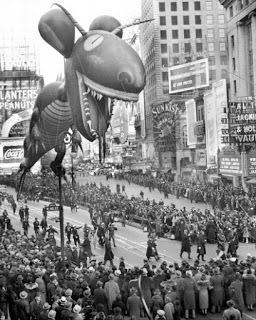
25 November 1937: balloons float down Broadway in the 13th annual Macy's Thanksgiving Day parade. Seven musical organisations, 21 floats and balloon units and 400 costumed marchers participated in this the event. (Photo by Walter Kelleher/NY Daily News Archive via Getty Images)
5) While turkey is today the bird of choice for Thanksgiving dinners across the United States, this was not always the case: according to History.com, for the first ever Thanksgiving in 1621 the Indians killed five deer as a gift for the colonists, meaning venison would most likely have been the dish of the day.
6) Each Thanksgiving, the president of the United States ‘pardons’ a hand-selected turkey, sending it to a farm where it lives out the rest of its days. But, contrary to popular belief, President George HW Bush was not in 1989 the first president to grant such a pardon.
According to the White House, the tradition dates to Lincoln’s days, when his son Tad begged him to write a presidential pardon for the bird meant for the family’s Christmas table, arguing it had as much a right to live as anyone. Lincoln complied, and the turkey lived.

7) Each Thanksgiving, millions of Americans tune in to watch the Detroit Lions play American Football. This tradition dates to 1934, when the team took on the undefeated, defending World Champion Chicago Bears of George Halas. Despite losing the inaugural game, since then the Lions have played football every Thanksgiving except between 1939 and 1944.

1) Tradition has it that the first Thanksgiving – a celebration of good harvest – took place in 1621, when English Pilgrims at Plymouth Plantation in Massachusetts shared a meal with their Native American neighbours. However, historian Michael Gannon told Florida Today that the first Thanksgiving celebration in North America actually took place in Florida half a century earlier.
On 8 September 1565, he says, following a religious service, Spaniards shared a communal meal with the local native tribe.
2) According to the US National Archives, on 28 September 1789 the first Federal Congress passed a resolution asking that the president of the United States recommend to the nation a day of thanksgiving. A few days later, George Washington issued a proclamation naming Thursday 26 November 1789 as a “Day of Publick Thanksgivin” – the first time Thanksgiving was celebrated under the new Constitution.
The dates of Thanksgiving celebrations varied as subsequent presidents came and went, and it wasn’t until Abraham Lincoln's 1863 Proclamation – in the midst of the Civil War – that Thanksgiving was regularly commemorated each year on the last Thursday of November.
3) The US National Archives says that in 1939, with the last Thursday in November falling on the last day of the month, Franklin D Roosevelt became concerned that the shortened Christmas shopping season might dampen economic recovery. He therefore issued a Presidential Proclamation moving Thanksgiving to the second to last Thursday of November.
Some 32 states consequently issued similar proclamations, but 16 states refused to accept the change. As a result, for two years two days were celebrated as Thanksgiving.
To end the confusion, on 6 October 1941 Congress set a fixed date for the holiday: it passed a joint resolution declaring the last Thursday in November to be the legal Thanksgiving Day.
4) The Macy's Thanksgiving Day Parade, which is televised nationally on NBC, has been marching since 1924. That year, the department store’s president, Herbert Strauss, organised a six-mile procession from Harlem to the Macy’s store in Herald Square. The parade featured animals – including elephants – from the Central Park Zoo, and was nearly three times as long as it is today: for the purposes of television filming, the route was later reduced to 2.5 miles.

25 November 1937: balloons float down Broadway in the 13th annual Macy's Thanksgiving Day parade. Seven musical organisations, 21 floats and balloon units and 400 costumed marchers participated in this the event. (Photo by Walter Kelleher/NY Daily News Archive via Getty Images)
5) While turkey is today the bird of choice for Thanksgiving dinners across the United States, this was not always the case: according to History.com, for the first ever Thanksgiving in 1621 the Indians killed five deer as a gift for the colonists, meaning venison would most likely have been the dish of the day.
6) Each Thanksgiving, the president of the United States ‘pardons’ a hand-selected turkey, sending it to a farm where it lives out the rest of its days. But, contrary to popular belief, President George HW Bush was not in 1989 the first president to grant such a pardon.
According to the White House, the tradition dates to Lincoln’s days, when his son Tad begged him to write a presidential pardon for the bird meant for the family’s Christmas table, arguing it had as much a right to live as anyone. Lincoln complied, and the turkey lived.

7) Each Thanksgiving, millions of Americans tune in to watch the Detroit Lions play American Football. This tradition dates to 1934, when the team took on the undefeated, defending World Champion Chicago Bears of George Halas. Despite losing the inaugural game, since then the Lions have played football every Thanksgiving except between 1939 and 1944.
Published on November 23, 2017 00:00
November 22, 2017
Old Norse Mystery: What Do the Couples Depicted on Thousands of Miniature Gold Amulets Symbolize?
Ancient Origins
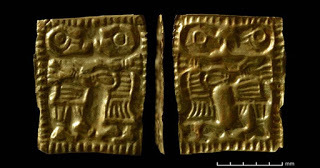
By ThorNews In 2016, a miniature amulet made of gold was discovered on the Åker farm near Hamar in Eastern Norway – one of many thousands only found in Scandinavia. About three thousand Old Norse gold miniature amulets dating back to the Merovingian and Viking periods (c. 500 – 1066 AD) have been found in Scandinavia. They show a man and a woman embracing, holding or looking at each other. The researchers do not know who the images portray or for what purpose they were made. However, a number of different theories have been put forward.
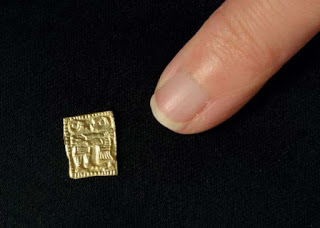
The gold amulets are extremely tiny, like the size of the little finger nail. (Photo: Vegard Vike and Jessica McGraw / Museum of Cultural History, Oslo)
Microscopic Detail
The stamped and cut-out amulets measure only 8 to 10 millimeters in cross-section and are approximately 0.03 millimeters thick, or thin as leaves.
In Scandinavia the miniature amulets have got the name gullgubber, meaning “little old men of gold”, because it was previously thought they were depicting two men. This has proven to be wrong and they almost exclusively picture a man and a woman.
The woman wears a dress and an apron, but there are several combinations. The man wears a robe and sometimes pants. Both sexes can wear outerwear in the form of a short or long coat.
Both sexes can be pictured with items such as buckles, neck rings, drinking mugs or scepters. The scepter can be in the form of a twig with leaves.
It may seem as the gold amulets are trying to tell us a story, and the stamps used must have been made by extremely skilled goldsmiths.
The details are impressive and can best be seen when enlarged under a microscope.
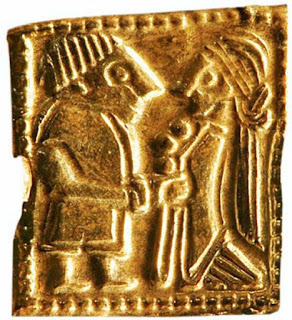
Details seen on one amulet when viewed under a microscope (Photo: Museum of Cultural History, Oslo)
Found in or Near Special Buildings
The biggest discovery was made at the Sorte Muld in Bornholm, Denmark, where more than 2500 gullgubber were found.
The amulets are frequently found in connection with buildings that are often interpreted as houses of worship. It looks as if the miniature images are placed there on purpose, especially around the post holes in the center of the building.
During excavations in 2005 and 2008, in what scientists believe could have been a Norse temple at Vingrom in Eastern Norway, about thirty miniature gold amulets were discovered around one of the post holes.
The building was at least 15 meters long and located at the Hov (Old Norse: Hof) farm not far from the Vingrom church. The farm name suggests that there probably has been a house of worship located on the property.
Surprisingly, there were also found many pieces of iron that together with flint were used as fire starting tools.

The building archaeologists assume has been a house of worship was located not far from the Vingrom church. (Photo: kirkesok.no, author provided)
Archaeologists have concluded that it is a house of worship due to the lack of everyday items like sharpening stones, clay cooking pots, and so on.
Furthermore, the building was strategically located visible over long distances at the end of Norway’s largest lake, Mjøsa.
Freyr and Gerðr
There are proposed as many theories about who are depicted on the miniature amulets and what they symbolize as there are researchers. The only certain thing is that these images did not have a practical function, but a spiritual.
One interpretation is that they are Norse mythological depictions of the “holy wedding” between the Vanir god Freyr and the jötunn woman Gerðr.
Freyr is the god associated with virility and prosperity, with sunshine and fair weather. He falls in love with the female jötunn Gerðr who, after some coercion, eventually becomes his wife. However, Freyr has to give away his magic sword that can fight on its own to get the woman he loves.
However, lacking his sword, Freyr is killed by the jötunn Surtr during the dramatic events of Ragnarök.
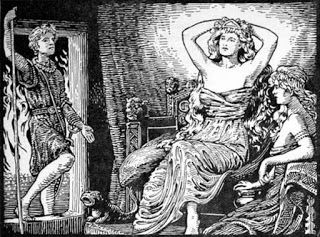
Skirnir's Message [from Freyr] to Gerd (1908) by W. G. Collingwood. (Public Domain)
Do the miniature images symbolize the marriage between Freyr and Gerðr and their unconditional love? Were the miniature gold amulets offered during wedding ceremonies to show that the married couple was willing to sacrifice everything, even their own lives for each other?
One of many other theories some researchers believe is that the amulets may have been a kind of entrance ticket for those who were found worthy to attend religious ceremonies.
Or do the miniature images represent something we simply do not understand?
We will probably never get the answer to this Old Norse mystery and we have to acknowledge that some puzzles will remain unresolved.
Top image: Gold miniature amulet (front and back) from the Åker farm in Hamar, Eastern Norway: Both male and female are depicted without hair, something that is unusual. (Photo: Vegard Vike and Jessica McGraw / Museum of Cultural History, Oslo)
The article ‘Old Norse Mystery: What Do the Couples Depicted on Thousands of Miniature Gold Amulets Symbolize?’ was originally published on ThorNews and has been republished with permission.

By ThorNews In 2016, a miniature amulet made of gold was discovered on the Åker farm near Hamar in Eastern Norway – one of many thousands only found in Scandinavia. About three thousand Old Norse gold miniature amulets dating back to the Merovingian and Viking periods (c. 500 – 1066 AD) have been found in Scandinavia. They show a man and a woman embracing, holding or looking at each other. The researchers do not know who the images portray or for what purpose they were made. However, a number of different theories have been put forward.

The gold amulets are extremely tiny, like the size of the little finger nail. (Photo: Vegard Vike and Jessica McGraw / Museum of Cultural History, Oslo)
Microscopic Detail
The stamped and cut-out amulets measure only 8 to 10 millimeters in cross-section and are approximately 0.03 millimeters thick, or thin as leaves.
In Scandinavia the miniature amulets have got the name gullgubber, meaning “little old men of gold”, because it was previously thought they were depicting two men. This has proven to be wrong and they almost exclusively picture a man and a woman.
The woman wears a dress and an apron, but there are several combinations. The man wears a robe and sometimes pants. Both sexes can wear outerwear in the form of a short or long coat.
Both sexes can be pictured with items such as buckles, neck rings, drinking mugs or scepters. The scepter can be in the form of a twig with leaves.
It may seem as the gold amulets are trying to tell us a story, and the stamps used must have been made by extremely skilled goldsmiths.
The details are impressive and can best be seen when enlarged under a microscope.

Details seen on one amulet when viewed under a microscope (Photo: Museum of Cultural History, Oslo)
Found in or Near Special Buildings
The biggest discovery was made at the Sorte Muld in Bornholm, Denmark, where more than 2500 gullgubber were found.
The amulets are frequently found in connection with buildings that are often interpreted as houses of worship. It looks as if the miniature images are placed there on purpose, especially around the post holes in the center of the building.
During excavations in 2005 and 2008, in what scientists believe could have been a Norse temple at Vingrom in Eastern Norway, about thirty miniature gold amulets were discovered around one of the post holes.
The building was at least 15 meters long and located at the Hov (Old Norse: Hof) farm not far from the Vingrom church. The farm name suggests that there probably has been a house of worship located on the property.
Surprisingly, there were also found many pieces of iron that together with flint were used as fire starting tools.

The building archaeologists assume has been a house of worship was located not far from the Vingrom church. (Photo: kirkesok.no, author provided)
Archaeologists have concluded that it is a house of worship due to the lack of everyday items like sharpening stones, clay cooking pots, and so on.
Furthermore, the building was strategically located visible over long distances at the end of Norway’s largest lake, Mjøsa.
Freyr and Gerðr
There are proposed as many theories about who are depicted on the miniature amulets and what they symbolize as there are researchers. The only certain thing is that these images did not have a practical function, but a spiritual.
One interpretation is that they are Norse mythological depictions of the “holy wedding” between the Vanir god Freyr and the jötunn woman Gerðr.
Freyr is the god associated with virility and prosperity, with sunshine and fair weather. He falls in love with the female jötunn Gerðr who, after some coercion, eventually becomes his wife. However, Freyr has to give away his magic sword that can fight on its own to get the woman he loves.
However, lacking his sword, Freyr is killed by the jötunn Surtr during the dramatic events of Ragnarök.

Skirnir's Message [from Freyr] to Gerd (1908) by W. G. Collingwood. (Public Domain)
Do the miniature images symbolize the marriage between Freyr and Gerðr and their unconditional love? Were the miniature gold amulets offered during wedding ceremonies to show that the married couple was willing to sacrifice everything, even their own lives for each other?
One of many other theories some researchers believe is that the amulets may have been a kind of entrance ticket for those who were found worthy to attend religious ceremonies.
Or do the miniature images represent something we simply do not understand?
We will probably never get the answer to this Old Norse mystery and we have to acknowledge that some puzzles will remain unresolved.
Top image: Gold miniature amulet (front and back) from the Åker farm in Hamar, Eastern Norway: Both male and female are depicted without hair, something that is unusual. (Photo: Vegard Vike and Jessica McGraw / Museum of Cultural History, Oslo)
The article ‘Old Norse Mystery: What Do the Couples Depicted on Thousands of Miniature Gold Amulets Symbolize?’ was originally published on ThorNews and has been republished with permission.
Published on November 22, 2017 00:00
November 20, 2017
Archaeologists Uncover Rare 2,000-year-old Roman Sundial and it Tells Them More than Just the Time
Ancient Origins
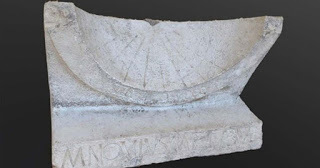
A 2,000-year-old intact and inscribed sundial – one of only a handful known to have survived – has been recovered during the excavation of a roofed theatre in the Roman town of Interamna Lirenas, near Monte Cassino, in Italy.
Not only has the sundial survived largely undamaged for more than two millennia, but the presence of two Latin texts means researchers from the University of Cambridge have been able to glean precise information about the man who commissioned it.
The sundial was found lying face down by students of the Faculty of Classics as they were excavating the front of one of the theatre’s entrances along a secondary street. It was probably left behind at a time when the theatre and town was being scavenged for building materials during the Medieval to post-Medieval period. In all likelihood it did not belong to the theatre, but was removed from a prominent spot, possibly on top of a pillar in the nearby forum.
Less than a hundred examples of this specific type of sundial have survived and of those, only a handful bear any kind of inscription at all – so this really is a special find,” said Dr Alessandro Launaro, a lecturer at the Faculty of Classics at Cambridge and a Fellow of Gonville & Caius College.
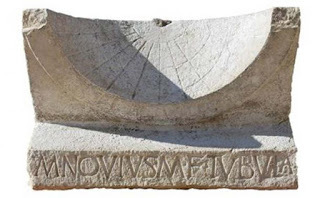
The sundial pictured after excavation. (Alessandro Launaro)
“Not only have we been able to identify the individual who commissioned the sundial, we have also been able to determine the specific public office he held in relation to the likely date of the inscription.”
The base prominently features the name of M(arcus) NOVIUS M(arci) F(ilius) TUBULA [Marcus Novius Tubula, son of Marcus], whilst the engraving on the curved rim of the dial surface records that he held the office of TR(ibunus) PL(ebis) [Plebeian Tribune] and paid for the sundial D(e) S(ua) PEC(unia) (with his own money).
The nomen Novius was quite common in Central Italy. On the other hand, the cognomen Tubula (literally ‘small trumpet’) is only attested at Interamna Lirenas.
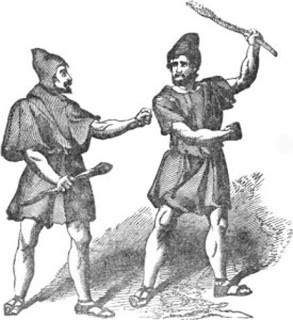
Image of Roman Plebeians. (serenitynaturalwellness)
But even more striking is the specific public office Tubula held in relation to the likely date of the inscription. Various considerations about the name of the individual and the lettering style comfortably place the sundial’s inscription at a time (mid 1st c. BC onwards) by which the inhabitants of Interamna had already been granted full Roman citizenship.
“That being the case, Marcus Novius Tubula, hailing from Interamna Lirenas, would be a hitherto unknown Plebeian Tribune of Rome,” added Launaro. “The sundial would have represented his way of celebrating his election in his own hometown.”
Roman sundial (Interamna Lirenas, Italy) by al506 on Sketchfab
Carved out from a limestone block (54 x 35 x 25 cm), the sundial features a concave face, engraved with 11 hour lines (demarcating the twelve horae of daylight) intersecting three day curves (giving an indication of the season with respect to the time of the winter solstice, equinox and summer solstice). Although the iron gnomon (the needle casting the shadow) is essentially lost, part of it is still preserved under the surviving lead fixing. This type of ‘spherical’ sundial was relatively common in the Roman period and was known as hemicyclium.
“Even though the recent archaeological fieldwork has profoundly affected our understanding of Interamna Lirenas, dispelling long-held views about its precocious decline and considerable marginality, this was not a town of remarkable prestige or notable influence,” added Launaro. “It remained an average, middle-sized settlement, and this is exactly what makes it a potentially very informative case study about conditions in the majority of Roman cities in Italy at the time”.
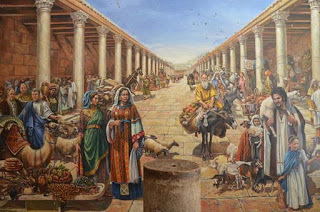
Artist’s reconstruction of life in a Roman cardo of Jerusalem during the Aelia Capitolina period. (Carole Raddato/CC BY SA 2.0)
“In this sense, the discovery of the inscribed sundial not only casts new light on the place Interamna Lirenas occupied within a broader network of political relationships across Roman Italy, but it is also a more general indicator of the level of involvement in Rome’s own affairs that individuals hailing from this and other relatively secondary communities could aspire to.”
The ongoing archaeological project at Interamna Lirenas continues to add new evidence about important aspects of the Roman civilization, stressing the high levels of connectivity and integration (political, social, economic and cultural) which it featured.
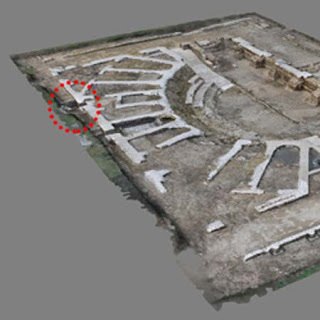
The find spot near the former roofed theatre in Interamna Lirenas. (CC BY 4.0)
The 2017 excavation, directed by Dr Launaro (Gonville & Caius College) and Professor Martin Millett (Fitzwilliam College), both from the Faculty of Classics, in partnership with Dr Giovanna Rita Bellini of the Italian Soprintendenza Archeologia, Belle Arti e Paesaggio per le Province di Frosinone, Latina e Rieti, is part of a long-standing collaboration with the British School at Rome and the Comune of Pignataro Interamna and has benefitted from the generous support of the Isaac Newton Trust and Mr Antonio Silvestro Evangelista.
Top Image: The Roman sundial. Source: Cambridge University
The article, originally titled ‘Archaeologists uncover rare 2,000-year-old sundial during Roman theatre excavation’, was originally published on University of Cambridge and has been republished under a Creative Commons license.
Published on November 20, 2017 23:30
Will Prince Charles Succeed in Reviving Long-Lost Foods from our Ancient Past?
Ancient Origins
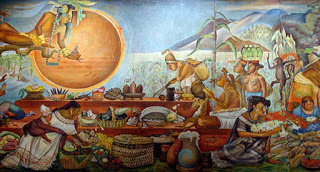
The Prince of Wales has launched a new initiative in the hope of finding “long-lost and unfashionable” foods that could grow in extreme climates and feed millions of people around the world. The project will attempt to reignite interest in nutritious ingredients used by the Aztecs, Incas, Mayas, Greeks and Romans, which have disappeared from kitchens in favor of the staple crops of wheat, rice, soybean and maize.
The Forgotten Foods Network
A team of scientists collaborating on a revolutionary project in order to rediscover forgotten foods that could be grown in extreme climates, has been blessed with Royal approval. Prince Charles launched the Forgotten Foods Network when he visited Crops For the Future (CFF), a collaboration between the University of Nottingham and the government of Malaysia that researches underutilized crops.
The network is destined to accumulate and share details on foods and recipes from all over the world that have been forgotten over the centuries. Scientists estimate that almost 95 per cent of what we consume today, comes from around thirty kinds of plants and animals. Four basic crops – wheat, maize, rice and soybean – are the main source of more than half of our food. According to the project press release, “The narrowing of diets to only a few key ingredients has coincided with an increase in the incidence of diet-related diseases linked with highly processed foods that are energy-rich yet nutrient-poor.”
Quinoa Shows the Way
As Nottingham Post reports, rising temperatures, changing rainfall patterns and other extreme climates are making soil less fertile and supplies of these basic foods uncertain. So the main challenge for the scientists at CFF is to rediscover and reintroduce little-known foods that are both nutrient rich, and have the potential to grow in a changing climate.
If they follow the lead of the rise of quinoa, they may indeed succeed in bringing change. Quinoa used to be exclusively grown in the highlands of Peru and the indigenous people of the Andes long knew of its nutritious properties. After many studies, planting and promotions during the 1990s, quinoa has made a worldwide revival and has become a favored healthy option worldwide.
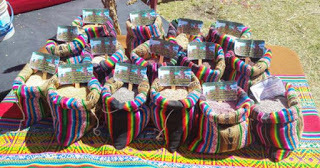
Varieties of quinoa on display in Peru (Bioversity International / flickr)
Prince Charles Tastes Forgotten Recipes
During his visit to Crops of the Future, Prince Charles tried some of the recipes, including kevaru roti, a type of millet grown in arid areas of Africa and Asia. “They’re good,” he said as The Telegraph reports and added, “And very nutritious as well, are they?” The menu also included biscotti using bambara groundnut rather than almond, as well as soup, mini-burgers and quiche made from the leaves of moringa tree, a superfood dating back to the Ancient Greeks and Romans. More elaborate dishes included dragon fruit tortellini with turmeric yoghurt and mint oil.
Nottingham Post reports that Prince Charles shared a video message in which he says: “It is essential we capture knowledge about forgotten foods, crops and animal sources, and act on this information before it is lost forever. We must move beyond the ‘business as usual’ approach of relying on monocultures of major, well-known crops, and invest in agricultural diversity which can not only help sustain agriculture, but also feed and nourish our growing population.”
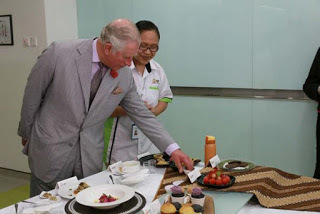
Prince Charles samples some ‘forgotten foods’. Credit: Crops for the Future
Scientists Suggest there are Thousands of Forgotten Foods
Scientists suggest that there are thousands of forgotten foods worldwide that are waiting to be used and help feed the planet’s poorer populations.
CFF Chief Executive Professor Sayed Azam-Ali, who established the Tropical Crops Research Unit at Nottingham's Sutton Bonington Campus in the 1980s, said “We need to put nutrition at the heart of our food systems. The Forgotten Foods Network can help identify foods that feed the future. The traditional foods and crops that our ancestors ate could play a vital role, especially in the unpredictable and vulnerable climates of the future.”
The first two submissions to the Forgotten Foods Network were from CFF researchers who recalled consuming a watermelon salad and a finger millet bread that were well-liked by their parents when they were still children. The Forgotten Foods Network is open to people from all over the world to submit their stories about foods and recipes they might remember to its website at: http://forgottenfoodsnetwork.org
Top image: Food in the Maya culture: mural, National Museum of Anthropology, Mexico City
By Theodoros Karasavvas

The Prince of Wales has launched a new initiative in the hope of finding “long-lost and unfashionable” foods that could grow in extreme climates and feed millions of people around the world. The project will attempt to reignite interest in nutritious ingredients used by the Aztecs, Incas, Mayas, Greeks and Romans, which have disappeared from kitchens in favor of the staple crops of wheat, rice, soybean and maize.
The Forgotten Foods Network
A team of scientists collaborating on a revolutionary project in order to rediscover forgotten foods that could be grown in extreme climates, has been blessed with Royal approval. Prince Charles launched the Forgotten Foods Network when he visited Crops For the Future (CFF), a collaboration between the University of Nottingham and the government of Malaysia that researches underutilized crops.
The network is destined to accumulate and share details on foods and recipes from all over the world that have been forgotten over the centuries. Scientists estimate that almost 95 per cent of what we consume today, comes from around thirty kinds of plants and animals. Four basic crops – wheat, maize, rice and soybean – are the main source of more than half of our food. According to the project press release, “The narrowing of diets to only a few key ingredients has coincided with an increase in the incidence of diet-related diseases linked with highly processed foods that are energy-rich yet nutrient-poor.”
Quinoa Shows the Way
As Nottingham Post reports, rising temperatures, changing rainfall patterns and other extreme climates are making soil less fertile and supplies of these basic foods uncertain. So the main challenge for the scientists at CFF is to rediscover and reintroduce little-known foods that are both nutrient rich, and have the potential to grow in a changing climate.
If they follow the lead of the rise of quinoa, they may indeed succeed in bringing change. Quinoa used to be exclusively grown in the highlands of Peru and the indigenous people of the Andes long knew of its nutritious properties. After many studies, planting and promotions during the 1990s, quinoa has made a worldwide revival and has become a favored healthy option worldwide.

Varieties of quinoa on display in Peru (Bioversity International / flickr)
Prince Charles Tastes Forgotten Recipes
During his visit to Crops of the Future, Prince Charles tried some of the recipes, including kevaru roti, a type of millet grown in arid areas of Africa and Asia. “They’re good,” he said as The Telegraph reports and added, “And very nutritious as well, are they?” The menu also included biscotti using bambara groundnut rather than almond, as well as soup, mini-burgers and quiche made from the leaves of moringa tree, a superfood dating back to the Ancient Greeks and Romans. More elaborate dishes included dragon fruit tortellini with turmeric yoghurt and mint oil.
Nottingham Post reports that Prince Charles shared a video message in which he says: “It is essential we capture knowledge about forgotten foods, crops and animal sources, and act on this information before it is lost forever. We must move beyond the ‘business as usual’ approach of relying on monocultures of major, well-known crops, and invest in agricultural diversity which can not only help sustain agriculture, but also feed and nourish our growing population.”

Prince Charles samples some ‘forgotten foods’. Credit: Crops for the Future
Scientists Suggest there are Thousands of Forgotten Foods
Scientists suggest that there are thousands of forgotten foods worldwide that are waiting to be used and help feed the planet’s poorer populations.
CFF Chief Executive Professor Sayed Azam-Ali, who established the Tropical Crops Research Unit at Nottingham's Sutton Bonington Campus in the 1980s, said “We need to put nutrition at the heart of our food systems. The Forgotten Foods Network can help identify foods that feed the future. The traditional foods and crops that our ancestors ate could play a vital role, especially in the unpredictable and vulnerable climates of the future.”
The first two submissions to the Forgotten Foods Network were from CFF researchers who recalled consuming a watermelon salad and a finger millet bread that were well-liked by their parents when they were still children. The Forgotten Foods Network is open to people from all over the world to submit their stories about foods and recipes they might remember to its website at: http://forgottenfoodsnetwork.org
Top image: Food in the Maya culture: mural, National Museum of Anthropology, Mexico City
By Theodoros Karasavvas
Published on November 20, 2017 00:30
November 19, 2017
Skeleton Found in Scotland Was 4,000-Year-Old Bronze Age Farmer
Ancient Origins
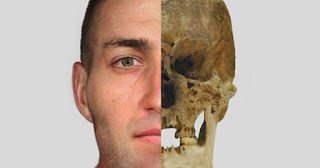
Human remains discovered 138 years ago in Stirling, Scotland, have been identified as belonging to a Bronze Age farmer who worked the land more than four millennia ago. This makes the man officially the earliest known resident of the ancient capital of Scotland.
Radiocarbon Testing Establishes “Torbrex Tam” as Earliest Resident
The remains of the young man were discovered back in 1879, when workmen were digging for gravel hit the slabs of a stone-lined cist as Daily Record reports . The human skeleton was buried inside a chambered cairn – a burial monument usually constructed during the Neolithic – on land belonging to a market garden, in 1872. The remains were given to the Smith Museum in Stirling for safekeeping, while the burial monument, which is the oldest structure in Stirling, is now surrounded by houses in Coney Park. The farmer, who died in his twenties, was nicknamed “Torbrex Tam” after the area of Torbrex in Stirling.
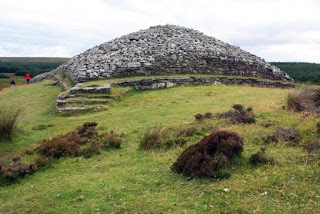
Example of a cairn burial monument in Scotland ( CC by SA )
Radiocarbon dating results have now officially verified that the young farmer’s remains date back to the Bronze Age, when Torbrex was a tiny community surrounded by water. Stirling archaeologist Murray Cook told Daily Record , “Torbrex Tam died around 2152 to 2021 BC. He is more than 4000 years old. He’s the oldest individual from Stirling.”
Reconstruction of Tam’s Face Reveals Strong Resemblance to Modern Residents
While researchers were trying to accurately date Tam’s remains, a team of forensic scientists started reconstructing his face based on his skull. “His facial reconstruction is Stirling’s first recorded face. For anyone from Stirling, Tam is their oldest ancestor. I’m sure I’ve seen his face in people around the town,” Dr. Cook tells Daily Record .
Dr. Cook also added that for the past six months he has collaborated with Michael McGinnes of Stirling’s Smith Art Gallery and Museum, as well as with Dundee University forensic art and facial identification graduate Emily McCulloch from Stirling, who was the expert that carried out the work on Tam’s facial reconstruction.

Torbrex Tam; facial reconstruction carried out by Emily McCulloch.
It seems that forensic scientists from the University of Dundee have been doing an excellent job lately. As we recently reported in another article , elite forensic scientists from the University of Dundee, digitally reconstructed the face of one of Scotland's most notorious “witches”, Lilias Adie. The only documents that helped them with their demanding scientific work, were a few photographs of her skull. According to Dr. Christopher Rynn, who directed that reconstruction work, the process was a step-by-step anatomical interpretation: sculpting musculature and estimating features (eyes, nose, mouth, ears) individually from the skull.
Second Excavation at the Site Uncovered More Human Remains A second excavation of the burial monument conducted by Stirling Archaeological Society back in the early 1970s, unearthed another cist and the human remains of a second individual, possibly a female in her 20s as well. The second cist found during the same excavation works contained a pot and the skeleton of a child aged around four. “At the time, average life expectancy was probably mid to late 20s; life was short, nasty and brutish. Infant mortality was high. What we have here is probably an extended family. There are a number of other burials in the immediate environs,” Dr. Murray Cook told Record Daily
He added, “I think the cairn is a family vault that’s been in use for a period of between 200 and 500 years. Different generations would have been buried in the cairn. However, it’s difficult to know if Tam and the bones thought to be female are man and wife. They could have been, but they could be brother and sister. The child is unlikely to be theirs, but it might be a grandchild or great grandchild.”
An exhibition featuring objects associated with “Torbrex Tam” is scheduled to take place at the Smith Museum in 2018.
Top image: Torbrex Tam; facial reconstruction carried out by Emily McCulloch
By Theodoros Karasavvas
Published on November 19, 2017 01:00
November 18, 2017
The Symbolic Key to a Viking Woman’s Independence
Ancient Origins
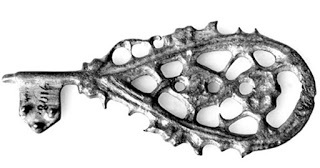
By ThorNews
A large number of ornate keys from the Viking Age (c. 800-1066 AD) have been found in female graves and as individual findings. Bronze keys made with superb craftsmanship were used as a status symbol by women and were often small works of art worn on a belt around the waist.
The key from Heggum farm (Old Norse: Heggheimar) is 9.5 centimeters long and ornamented with intertwined animal figures. It was found in a burial mound and may have belonged to a powerful housewife. The day she got married, she got the keys to the farm doors and treasure chests as a visible sign of her position and power.

Replica: A push key padlock from the Viking Age was found on the Björkö island in Lake Mälaren, Sweden. (Photo: historicallocks.com)
Women’s Work Duties
A Viking woman’s responsibility was “inside the doorstep,” the man’s outside. Her work duties were housekeeping and making food, including drying and smoking fish and meat, working wool, spinning yarn and sewing and weaving.
Pregnancy, breastfeeding and raising children also took up time in a woman’s life. In practice, it was probably the women who looked after the elderly.
She also had to perform heavy work like carrying water and participate in haymaking. In addition, she would have had knowledge of herbs to make medicine for the sick and wounded.
When the man went hunting, fishing, on Viking raids or got sick, the wife had responsibility for the operation of the whole farm, which in wealthy families also included many trells (slaves).
The married woman was seen to belong to the family she had grown up with and for that reason never quite became an integral part of her husband’s family.
Right to Divorce
If a marriage did not work out, both wife and husband could demand divorce. The Icelandic sagas describe a wide range of divorce laws which testifies to a quite advanced law system.
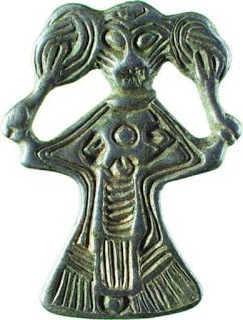
Silver figure of a woman, perhaps the goddess Frigg or Freya, found at the Tissø lake, Denmark. (Photo: National Museum of Denmark)
The woman could, for example, demand a divorce if the husband had settled in a new country, or had not gone to bed with her in three years. The most common causes of divorce were that her husband failed to provide for the household or was violent. If he had beaten his woman three times, she could leave him.
To carry out the act, she had to summon witnesses and proclaim herself divorced – first at the front door and later at the couple’s bed.
We do not know the divorce rate in the Viking Age, but the right to divorce, property and inheritance shows that women had an independent legal status. Usually infants and small children followed their mother, while the older children were divided between the parents’ families, depending on wealth and status.
The Viking women’s rights lapsed with the introduction of Christianity.
Top image: This bronze key from Heggum farm in Røyken in the Oslofjord is dated to the Viking Age. (Photo: Eirik Irgens Johnsen, Oldsakssamlingen)
The article ‘Keys Symbols of the Viking Women’s Independence’ by Thor Lanesskog was originally published on Thor News and has been republished with permission.
Published on November 18, 2017 00:00
November 17, 2017
Family Accidentally Discovers 2,000-Year-Old Roman Stables in Their Backyard
Ancient Origins
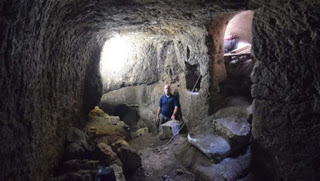
A family living in Israel was digging in their backyard when they came upon an opening in the ground. They were stunned when they discovered that it led to a complex network of underground caves. Archaeological investigations revealed it was an elaborate construction dating back 2,000 years, which probably served as stables.
Unexpected Find
Haaretz reported that the underground complex was discovered in a village called Eilabun, located just 11 miles from Nazareth, the ancient city where Jesus was said to have been raised.
Archaeologists suggest that the caves had been dug out by the Romans and probably served for storage and stabling. They came to this conclusion after noticing holes chiseled into the cave walls to which horses could have been tied, and a stone trough used for water or feed.
Interestingly, the caves are about three meters below the surface as archaeology inspector Nir Distelfeld told Haaretz. This made some archaeologists wonder how the horses could have got down there and why the Romans didn’t build a stable with walls above ground. However, Distelfeld has a logical explanation, “It’s three meters underground today, but 2,000 years ago, when in use, it would have been ground level, maybe half a meter lower but obviously the horse wasn’t lowered down,” he tells Haaretz. And adds, “It shows how much dirt and silt accrues over 2,000 years. Otherwise they would indeed have built stables and storage, not cut them into the rock.”
According to Haaretz, ancient Jews would carve caves out of the chalky, rather soft bedrock. The archaeologists discovered a large central chamber about 4x6 meters, which was at least two meters in height. Smaller chambers branched off that main one.
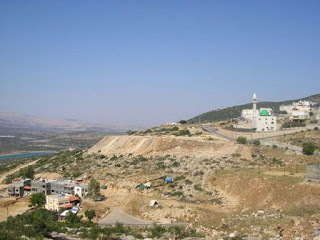
The village of Eilabun, where the underground stables were found (public domain)
Site Severely Damaged from Looters
Thanks to some broken pieces of pottery left behind by thieves who had looted the site exhaustively before its official discovery, experts were able to estimate that the complex dates back around 2,000 years. Thieves had removed and most likely sold everything of value they found there. What’s even worse, they broke and damaged the rock while searching for more places to loot. “The looters weren’t archaeology experts. When they saw a chamber, they started to deepen it, breaking the rock itself, thinking they would find other interesting stuff,” Distelfeld told Haaretz.
Another object the thieves left behind, other than the broken pieces of Roman-era ceramic storage jars, is a basalt rock with a groove down the middle, which had been part of a flour-grinding apparatus. “The thieves may have found other things but they won’t tell us,” a disappointed Distelfeld said.
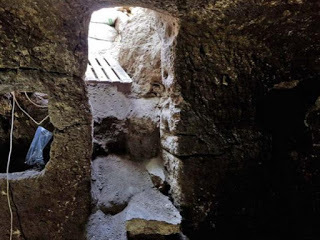
The entrance to the cave in the Galilean village of Eilabun. Credit: Israel Antiquities Authority
Eilabun’s Interesting Past
The village of Eilabun has a long history. Pottery remains from the Middle Bronze Age, Iron Age II, Persian, early Roman and from the Byzantine era have all been excavated there, while rock-cut sarcophagi have been unearthed to the west of the village.
Elibabun is mentioned as one of the cities associated with one of the twenty-four priestly divisions, the residence of the priestly clan known as Haqoṣ. A stone inscription mentioning the town was discovered in Yemen by orientalist, Walter W. Muller, in 1970, and is considered to have been part of a destroyed synagogue, now turned mosque.
Ultimately, Haaretz reports that soon after the caves’ official discovery by the Israel Antiquities Authority, two thieves were arrested in a joint campaign by the IAA inspectors with police. “At the moment we are working on criminal proceedings. We will look into further excavations there in the future,” Distelfeld told Haaretz, explaining why there are no active excavations at the moment in the area.
Top image: Roman-era stables discovered in the Galilean village of Eilabun, Israel. Credit: Israel Antiquities Authority
By Theodoros Karasavvas
Published on November 17, 2017 00:00
November 16, 2017
Valuable Jewels, Ornate Lamps and Coins Unearthed from 2,000-Year-Old Tombs in Corinth
Ancient Origins
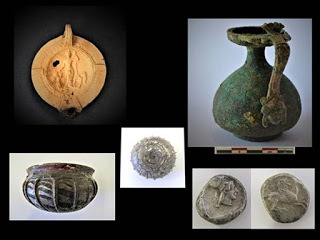
A team of Greek researchers has unearthed unique jewels, coins and other precious artifacts while excavating tombs near the ruins of the ancient city of Corinth. Experts estimate that the newly found objects date between the fourth and first centuries AD.
Unique Jewels and Coins Excavated Near Ancient Corinth
Τhe team of scientists led by Elena Korka of the Greek Ministry, discovered the rare artifacts in eastern Corinthia, at the site of the ancient village of Tenea, during excavation works at a burial ground with two characteristic chambers built when Greece was part of the Roman Empire, as Newsweek reports. The Greek Ministry of Culture announced in a statement that the Greco-Roman burial structures were most likely constructed during a Hellenistic period between the death of Alexander the Great in 323 BC, up until the Battle of Corinth in 146 BC. Archaeologists suggest that five of the better equipped tombs probably belonged to rich ancient Corinthian residents. The bodies were found alongside intricate gilded bronze leaves, a golden ring, valuable stones, as well as gold and bronze coins from the surrounding region as Newsweek reports. Other characteristic items of rituals buried with the dead included perfumes, artifacts made of gold, gold foil and beautifully crafted glassware, as well as items of pottery.
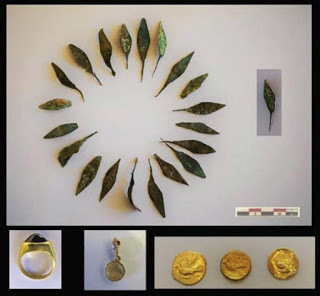
Gilded bronze leaves, a gold ring, valuable stone and coins were found. (Image: Greek Ministry of Antiquities)
Several Graves Organized in Circles
Furthermore, the researchers also excavated from the dig site many different burial plots. Interestingly, fourteen of the graves had been organized in circles – a common Roman tradition. These burials yielded gold and silver coins, vases, and lamps depicting the goddess Venus and two cupids. “Roman-period builders also repurposed the limestone foundations of earlier Greek structures to build the tombs for wealthy, Roman-era occupants,” Elena Korka said as Newsweek reports. Evidence of graves from the earlier Greek period was also traced in other areas of the dig site, including a figurine in the shape of a dove.
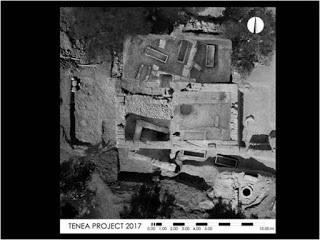
The Tenea dig site of 2017. (Image: Greek Ministry of Antiquities)
Greek Culture Conquered Its Roman Conquerors
By using the term “Roman Greece”, historians describe the period of Greek history following the Roman victory over the Corinthians, at the Battle of Corinth (146 BC), until the adoption of the city of Byzantium by the Emperor Constantine the Great as the capital of the Byzantine Empire. Regardless, some Greek cities (such as Pergamon) managed to maintain partial independence and avoid taxation. Most importantly, however, the Greeks were able to maintain a cultural autonomy from their Roman conquerors during the early period of empire, thanks to their rich civilization. Many temples and public buildings were built in Greece by emperors and wealthy Roman nobility, while this would become the longest period of peace in Greek history.
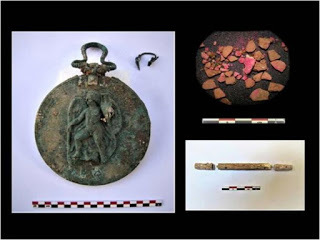
Items found included, gold items, glassware and pottery. (Image: Greek Ministry of Antiquities)
Even though a few Roman nobles regarded the Greeks as petty and inferior, the majority of Romans embraced Greek literature and philosophy. The Greek language became a favorite of the educated and elite Roman citizens, such as Scipio Africanus, who tended to study philosophy and regard Greek culture and science as an example to be followed.
Similarly, most Roman emperors maintained an admiration for things Greek in nature. Hadrian, for example, was known to be fond of the Greeks and before he would become emperor he served as an eponymous archon of Athens, where he constructed the famous Arch of Hadrian.

Arch of Hadrian, Athens. (CC BY-SA 3.0)
Corinth in particular – which was partially destroyed by the Romans in 146 BC – was rebuilt in 44 BC as a Roman city under Julius Caesar. Roman Corinth prospered more than any other Greek city at the time and according to various historical accounts, it had as many as 800,000 inhabitants by the time of Paul. It was the capital of Roman Greece, equally devoted to merchants and entertainment.
Generally speaking, one could say that life in Greece continued under the Roman Empire much the same as it had previously (minus the civil wars). And even though the exhausted Greek city-states after hundreds of years of wars (against each other in most cases) were conquered by the Roman military on the battlefield, it was Roman culture that was conquered by the Greeks, a fact that is best highlighted on Horace’s quotation, “Graecia capta ferum victorem cepit” (translated: Captive Greece captured her rude conqueror).
Top image: The findings included vases and a series of lamps, notably some included depictions of the Roman goddess Venus and two cupids. (Image: Greek Ministry of Antiquities)
By Theodoros Karasavvas
Published on November 16, 2017 00:00
November 15, 2017
Q&A: How did pasta come to Europe and when did it first become established in Italy?
History Extra

That the food crops up in so many cultures isn’t surprising: pasta is basically unleavened bread that has been boiled rather than baked.
There was long a fond myth that Marco Polo (1254–1324) brought pasta back to Italy from his travels in China, though what in fact he said was that he had found the Chinese eating lagana (sheets or ribbons of noodles or wheat pasta) similar to that already found in Italy.
Pasta as we know it today, made from durum wheat and water, was being produced in Sicily by the 12th century (and probably much earlier), and was probably introduced by Arab colonists. North Africa’s variation on pasta is, of course, couscous. It’s thought the Arabs used dried noodles on journeys and military campaigns as it kept well for long periods. Dried pasta would later be used by European seafarers.
Pasta spread across Italy where production remained hard, physical work; pasta-makers would generally sit and knead the dough with their feet. For this reason, it was expensive until industrialised kneading and extrusion methods were pioneered in Naples in the late 1700s. Only then did it become part of the diet of most Italians, before spreading across the world.
Answered by Eugene Byrne, author and historian.
Published on November 15, 2017 01:00
November 14, 2017
Leprechauns: At the End of the Rainbow Lies Richness for Irish Folklore
Ancient Origins
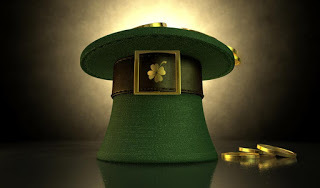
Those little men all dressed in green, obsessed with rainbows and treasure, trickery, and of course shoe-making. These are all common perceptions today regarding the famous characters from Irish folklore: Leprechauns. The characteristics of these mythical creatures has transformed over the years and much of what made the little people special in the original tales has been forgotten.
Etymology for the Word Leprechaun
Many scholars believe that the origin of the word leprechaun is the old Irish Lú Chorpain meaning small body. Another definition has linked the modern name to luchorpán (a word from the 8th century AD) which is defined as sprite or pygmy. Finally, the word leprechaun has been connected to leath bhrógan (shoe maker). This definition is also a possibility as many stories about leprechauns have shown their profession to be the cobblers of the fairy world.
The word lubrican, another word associated with leprechaun, first was written in English in 1604 in the play The Honest Whore by Thomas Middleton and Thomas Dekker. The line from the play states: "as for your Irish lubrican, that spirit whom by preposterous charms thy lust hath rais'd in a wrong circle…"
The Ancient Leprechauns
Leprechauns are thought to have been one of the many types of inhabitants of the fairy forts or fairy rings in ancient Ireland. It has been suggested that the merry tricksters of today may even be a modern incarnation of the Euro-Celtic god Lugh (pronounced “Luck”). Lugh was said to be the sun god, patron of arts and crafts and leader of the Tuatha Dé Danann ("peoples of the goddess Danu"
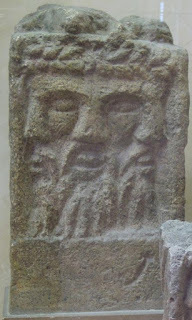
Altar depicting a tricephalic god identified as Lugus (Lugh), discovered in Reims. (Wikipedia)
Medieval Irish manuscripts (12th -15th Centuries) believed to be associated with leprechauns suggest that leprechauns were originally beings that lived underwater and, contrary to today’s depiction, they weren’t all male. They were depicted as warriors with voracious appetites and the female leprechauns were especially engrossed with luring away human men for secret adventures. These characteristics seemed to continue at least until the aforementioned writing in 1604.
Early leprechauns were described as sly old men that wore red suits and were often found working on a solitary shoe. The word solitary was also applied to the social preferences of leprechauns who seemed to prefer time alone to interacting with other faerie creatures, or even other leprechauns. There friendless nature perhaps was also partly due to others avoiding them – early leprechauns were also thought to be particularly mischievous house-haunting drunkards. These characteristics were later passed on to the leprechaun “cousins” the clobhair-ceann or clurichaun, an Irish fairy that is always drunk and rude. The clurichaun got the blame for noisy nights and messy homes (especially wine cellars).
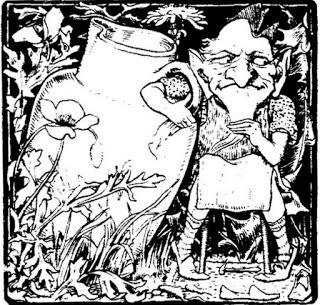
An illustration of a clurichaun, cousin of the leprechauns. (1862) T.C. Croker (Wikimedia Commons)
Changes in Leprechaun Traits: Now a Wealthy Shoemaker
By 1825, the leprechaun population was limited to only males. T. Crofton Croker's Fairy Traditions and Legends of the South of Ireland provided more insight on traits of these mythical creatures: “They are often described as bearded old men dressed in green and wearing buckled shoes. Sometimes they wear a pointed cap or hat and may smoke a pipe.”
The Leprechauns of the time were thought to be particularly stylish. Both Samuel Lover, writing in 1831, and William Butler Yeats (in 1888) made mention of the importance leprechauns placed in their appearance.
Lover wrote that a leprechaun was:
“…quite a beau in his dress, notwithstanding, for he wears a red square-cut coat, richly laced with gold, waistcoat and inexpressible of the same, cocked hat, shoes and buckles.”
Following that, Yeats later added:
“He is something of a dandy, and dresses in a red coat with seven rows of buttons, seven buttons on each row, and wears a cocked-hat, upon whose pointed end he is wont in the north-eastern counties, according to McAnally, to spin like a top when the fit seizes him.”
The 18th Century poem by William Allingham entitled The Lepracaun; Or, Fairy Shoemaker further promoted the idea that in the fairy realm occupations are chosen by group, and leprechauns were in charge of keeping the rest of the community’s feet happy. He also provided a hint to people searching for leprechauns (more on why soon) – the presence of leprechauns can be noted by their tapping sounds as they work:
"Lay your ear close to the hill.
Do you not catch the tiny clamor,
Busy click of an elfin hammer,
Voice of the Lepracaun singing shrill
As he merrily plies his trade?"
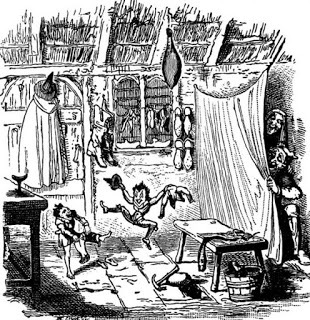
‘Elves and the Shoemaker’, originally from ‘The Book of Fables and Folk Stories’, by Horace E. Scudder. Illustration by George Cruikshank (Wikipedia)
Allingham is often credited as the creator of the “modern leprechaun”: a short man with a red beard, a green hat in which a golden four-leaf clover (symbol of good luck) is tucked, and a green suit with a large buckle on its belt.
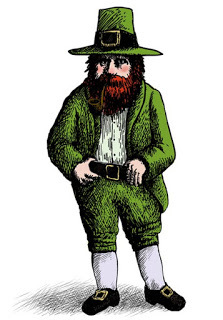
A modern stereotype of a leprechaun. (Wikimedia Commons)
The Moral behind Leprechauns
By the 1800s the perception of leprechauns as wealthy, clever folks was a common notion. Thus the old “wee” (small) fellows were depicted in stories with a strong interest in protecting their gold from the greedy humans that sought it out. Leprechauns are supposed to offer bribes to humans if caught in order to regain their freedom.
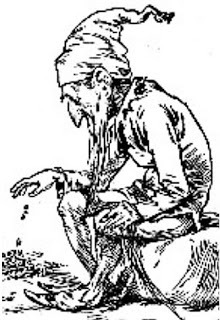
Engraving of a Leprechaun counting his gold, 1900 (Wikimedia Commons)
The legends about leprechauns not surprisingly focus mostly on a human catching a leprechaun then trying to attain their wealth. The most common story involves a boy or farmer who finds a leprechaun and forces him to tell where he has hidden his gold. The leprechaun is obliged to show him to the spot, which is below a tree or plant. As the human is without a shovel he ties a red cloth around the nearby tree/plant and makes the leprechaun swear he will not remove the indicator. When the person returns with the shovel he finds that there are now many red cloths and the leprechaun has vanished. Thus the leprechaun has managed to trick the human and maintains possession of his gold.
Another similar story tells of a girl who catches the leprechaun and makes him lead her to his treasure, but along the way hears a noise to which the leprechaun tells her there are bees chasing her. When she turns around to look, the leprechaun disappears.
Also according to some legends a leprechaun carries two leather pouches. He has a silver shilling in one which returns to his pouch whenever it has been given. The other pouch has a gold coin which is said to turn into leaves or ashes once the leprechaun is set free.
Another widespread interpretation of events after humans find and catch leprechauns is the offering of three wishes to which the capturer goes insane or is tricked as his wishes backfire. A popular story of this sort is that of Seamus. Seamus was a man from County Mayo who caught a leprechaun and was offered wishes. He chose to be the richest man on a tropical island. His wish was said to have come true, but there was a catch – there were no pubs, shops or other people on the island. Seamus got bored and eventually wished to be back in Ireland.
All of these stories present the same morals: getting rich quick doesn’t work out in the long run, stealing is wrong, and don’t mess with the Irish faerie folk.
The Fascination Leprechauns Continue to Hold
Leprechauns are now understood to be the fairy tales of the past and fanciful stories to tell when one sees a rainbow. However there is still a hold these little folk have on modern society. In Dublin there is even a Leprechaun museum which provides tours and detailed information on leprechauns and Irish folklore throughout the ages. Some Irish-themed sites also provide readers with tips and tricks on how to catch a leprechaun (and what to do when you have).
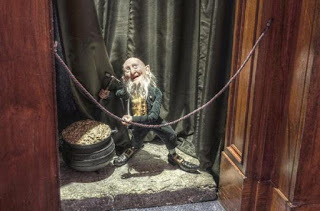
Leprechaun, Wax Museum Plus, Ireland (Wikimedia Commons)
On the other side of the pond, General Mills cereal’s Lucky Charms has “Lucky” the leprechaun to keep children entertained while they consume the sugar-filled product for which he is the mascot. There are also horror/comedy movies that are focused on a monstrous trickster of a leprechaun to torment adults.
Leprechauns may not really provide us a treasure of gold and silver, but they certainly have provided richness to Irish folklore.
Featured Image: A Leprechaun’s hat. (Albund | Dreamstime.com)
By Alicia McDermott

Those little men all dressed in green, obsessed with rainbows and treasure, trickery, and of course shoe-making. These are all common perceptions today regarding the famous characters from Irish folklore: Leprechauns. The characteristics of these mythical creatures has transformed over the years and much of what made the little people special in the original tales has been forgotten.
Etymology for the Word Leprechaun
Many scholars believe that the origin of the word leprechaun is the old Irish Lú Chorpain meaning small body. Another definition has linked the modern name to luchorpán (a word from the 8th century AD) which is defined as sprite or pygmy. Finally, the word leprechaun has been connected to leath bhrógan (shoe maker). This definition is also a possibility as many stories about leprechauns have shown their profession to be the cobblers of the fairy world.
The word lubrican, another word associated with leprechaun, first was written in English in 1604 in the play The Honest Whore by Thomas Middleton and Thomas Dekker. The line from the play states: "as for your Irish lubrican, that spirit whom by preposterous charms thy lust hath rais'd in a wrong circle…"
The Ancient Leprechauns
Leprechauns are thought to have been one of the many types of inhabitants of the fairy forts or fairy rings in ancient Ireland. It has been suggested that the merry tricksters of today may even be a modern incarnation of the Euro-Celtic god Lugh (pronounced “Luck”). Lugh was said to be the sun god, patron of arts and crafts and leader of the Tuatha Dé Danann ("peoples of the goddess Danu"

Altar depicting a tricephalic god identified as Lugus (Lugh), discovered in Reims. (Wikipedia)
Medieval Irish manuscripts (12th -15th Centuries) believed to be associated with leprechauns suggest that leprechauns were originally beings that lived underwater and, contrary to today’s depiction, they weren’t all male. They were depicted as warriors with voracious appetites and the female leprechauns were especially engrossed with luring away human men for secret adventures. These characteristics seemed to continue at least until the aforementioned writing in 1604.
Early leprechauns were described as sly old men that wore red suits and were often found working on a solitary shoe. The word solitary was also applied to the social preferences of leprechauns who seemed to prefer time alone to interacting with other faerie creatures, or even other leprechauns. There friendless nature perhaps was also partly due to others avoiding them – early leprechauns were also thought to be particularly mischievous house-haunting drunkards. These characteristics were later passed on to the leprechaun “cousins” the clobhair-ceann or clurichaun, an Irish fairy that is always drunk and rude. The clurichaun got the blame for noisy nights and messy homes (especially wine cellars).

An illustration of a clurichaun, cousin of the leprechauns. (1862) T.C. Croker (Wikimedia Commons)
Changes in Leprechaun Traits: Now a Wealthy Shoemaker
By 1825, the leprechaun population was limited to only males. T. Crofton Croker's Fairy Traditions and Legends of the South of Ireland provided more insight on traits of these mythical creatures: “They are often described as bearded old men dressed in green and wearing buckled shoes. Sometimes they wear a pointed cap or hat and may smoke a pipe.”
The Leprechauns of the time were thought to be particularly stylish. Both Samuel Lover, writing in 1831, and William Butler Yeats (in 1888) made mention of the importance leprechauns placed in their appearance.
Lover wrote that a leprechaun was:
“…quite a beau in his dress, notwithstanding, for he wears a red square-cut coat, richly laced with gold, waistcoat and inexpressible of the same, cocked hat, shoes and buckles.”
Following that, Yeats later added:
“He is something of a dandy, and dresses in a red coat with seven rows of buttons, seven buttons on each row, and wears a cocked-hat, upon whose pointed end he is wont in the north-eastern counties, according to McAnally, to spin like a top when the fit seizes him.”
The 18th Century poem by William Allingham entitled The Lepracaun; Or, Fairy Shoemaker further promoted the idea that in the fairy realm occupations are chosen by group, and leprechauns were in charge of keeping the rest of the community’s feet happy. He also provided a hint to people searching for leprechauns (more on why soon) – the presence of leprechauns can be noted by their tapping sounds as they work:
"Lay your ear close to the hill.
Do you not catch the tiny clamor,
Busy click of an elfin hammer,
Voice of the Lepracaun singing shrill
As he merrily plies his trade?"

‘Elves and the Shoemaker’, originally from ‘The Book of Fables and Folk Stories’, by Horace E. Scudder. Illustration by George Cruikshank (Wikipedia)
Allingham is often credited as the creator of the “modern leprechaun”: a short man with a red beard, a green hat in which a golden four-leaf clover (symbol of good luck) is tucked, and a green suit with a large buckle on its belt.

A modern stereotype of a leprechaun. (Wikimedia Commons)
The Moral behind Leprechauns
By the 1800s the perception of leprechauns as wealthy, clever folks was a common notion. Thus the old “wee” (small) fellows were depicted in stories with a strong interest in protecting their gold from the greedy humans that sought it out. Leprechauns are supposed to offer bribes to humans if caught in order to regain their freedom.

Engraving of a Leprechaun counting his gold, 1900 (Wikimedia Commons)
The legends about leprechauns not surprisingly focus mostly on a human catching a leprechaun then trying to attain their wealth. The most common story involves a boy or farmer who finds a leprechaun and forces him to tell where he has hidden his gold. The leprechaun is obliged to show him to the spot, which is below a tree or plant. As the human is without a shovel he ties a red cloth around the nearby tree/plant and makes the leprechaun swear he will not remove the indicator. When the person returns with the shovel he finds that there are now many red cloths and the leprechaun has vanished. Thus the leprechaun has managed to trick the human and maintains possession of his gold.
Another similar story tells of a girl who catches the leprechaun and makes him lead her to his treasure, but along the way hears a noise to which the leprechaun tells her there are bees chasing her. When she turns around to look, the leprechaun disappears.
Also according to some legends a leprechaun carries two leather pouches. He has a silver shilling in one which returns to his pouch whenever it has been given. The other pouch has a gold coin which is said to turn into leaves or ashes once the leprechaun is set free.
Another widespread interpretation of events after humans find and catch leprechauns is the offering of three wishes to which the capturer goes insane or is tricked as his wishes backfire. A popular story of this sort is that of Seamus. Seamus was a man from County Mayo who caught a leprechaun and was offered wishes. He chose to be the richest man on a tropical island. His wish was said to have come true, but there was a catch – there were no pubs, shops or other people on the island. Seamus got bored and eventually wished to be back in Ireland.
All of these stories present the same morals: getting rich quick doesn’t work out in the long run, stealing is wrong, and don’t mess with the Irish faerie folk.
The Fascination Leprechauns Continue to Hold
Leprechauns are now understood to be the fairy tales of the past and fanciful stories to tell when one sees a rainbow. However there is still a hold these little folk have on modern society. In Dublin there is even a Leprechaun museum which provides tours and detailed information on leprechauns and Irish folklore throughout the ages. Some Irish-themed sites also provide readers with tips and tricks on how to catch a leprechaun (and what to do when you have).

Leprechaun, Wax Museum Plus, Ireland (Wikimedia Commons)
On the other side of the pond, General Mills cereal’s Lucky Charms has “Lucky” the leprechaun to keep children entertained while they consume the sugar-filled product for which he is the mascot. There are also horror/comedy movies that are focused on a monstrous trickster of a leprechaun to torment adults.
Leprechauns may not really provide us a treasure of gold and silver, but they certainly have provided richness to Irish folklore.
Featured Image: A Leprechaun’s hat. (Albund | Dreamstime.com)
By Alicia McDermott
Published on November 14, 2017 01:00



